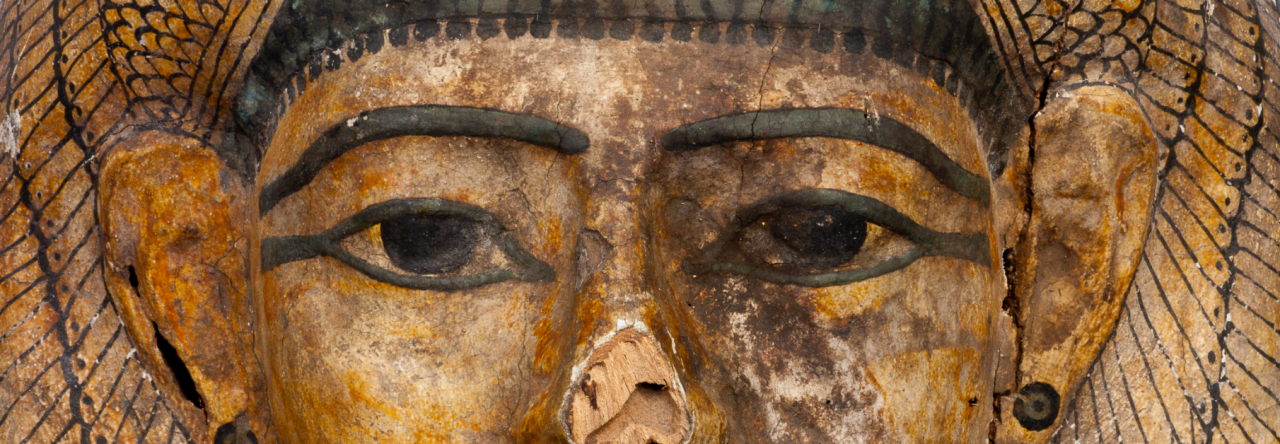
For a 3D model made by the Virtual Curation Lab at Virginia Commonwealth University, see https://skfb.ly/oHL9V.
Dagger
AWG0000.03.01
Iran, Luristan
Iron Age I (ca. 1200 - 1000 BCE)
Material: Bronze
Technique: Cast
Weight: 137g
Dimensions: 28.5 cm in total length (blade 25.2 cm, flat tang with rivet-hole 3.3 cm), maximum width 4.3 cm, maximum thickness 0.6 cm
Condition: Fair - some corrosion and blue-green spots as a result of bronze disease
Provenance: Unknown, said to be from Amalash, North Iran
Source/donor: Unknown
Date of acquisition: Unknown
Research by: Danny Saravia Romero ‘23
Description:
Cast dagger with a short tang that has a single rivet hole. Sharply angled shoulder. Slightly convex blade with a low, flat mid rib.
Comparanda:
Similar in size, shape, and style though slightly longer is Metropolitan Museum of Art 54.55.7 (Muscarella 287, no. 392), which Muscarella identified as coming from Iran, early first millennium BCE. Similar bronze daggers from Luristan are also found in the Ashmolean Museum, Oxford (Moorey 1971, objects 38-40; see also Ashmolean AN1951.135 and AN1963.1556). For another similar bronze dagger from Luristan, see Khorasani, fig. 1. For similar tang and rivet, as well as shape and length see a dagger blade from “Amlash” sold by St. James’s Ancient Art.
Discussion:
This bronze dagger was likely cast around 1000 BCE in an open mold, then hammered and annealed (Khorasani, 198). The dagger was most likely attached to a handle made from some form of organic material that was not preserved. Based on comparanda, it probably comes from the region of Luristan in northwestern Iran. In Luristan, daggers and dirks up to the second half of the 2nd millennium BCE were simple bronze or copper blades with tangs (Khorasani, 201-202). An old label says “from Amlash, N. Iran, c. 1000 BC,” but the term “Amlash” covers an assortment of materials and periods rather than a specific place. It has no real archeological meaning when used with the word “culture,” although it does indicate a geographical region from which objects of certain types come (Dyson). We don’t have any solid records or provenance of when the bronze dagger came into our collection; however, it is likely that it was acquired during or after the 1920s, when the area was subject to heavy looting (Khorasani, 181). The large-scale plundering of tombs is thought to have started in the late 1920s, and by 1930 Luristan was recognized worldwide. Antiquities from Luristan with unknown provenances continued to flood the antiquities markets in large quantities even after World War II (Overlaet, Chronology).
Bibliography:
Bazin, Marcel. “AMLAŠ i. Geography,” Encyclopaedia Iranica, I/9, p. 976, available online at http://www.iranicaonline.org/articles/amlas-geography (last updated December 30, 2012).
Birmingham, J., N. F. Kennon, and A. S. Malin. 1964. “A ‘Luristan’ Dagger: An Examination of Ancient Metallurgical Techniques.” Iraq 26, no. 1: 44–49. https://www.jstor.org/stable/4199759
Dyson, R.H. “AMLAŠ ii. Excavations,” Encyclopaedia Iranica, I/9, p. 976, available online at http://www.iranicaonline.org/articles/amlas-excavations (last updated December 30, 2012).
Gordon, Douglas H. 1953. "Swords, rapiers and Horse-riders." Antiquity 27, no. 106: 67-78.
Howard, Dan. Bronze Age military equipment. Casemate Publishers, 2011.
Khorasani, Manouchehr Moshtagh. 2009. “Bronze and Iron Weapons from Luristan.”
Antiguo Oriente: Cuadernos del Centro de Estudios de Historia del Antiguo Oriente. 7. https://repositorio.uca.edu.ar/handle/123456789/7229
Moorey, P.R.S. 1971. Catalogue of the ancient Persian bronzes in the Ashmolean Museum. Oxford: Clarendon Press.
Muscarella, Oscar White. 1988. Bronze and Iron Ancient Near Eastern Artifacts in the Metropolitan Museum of Art. New York: Metropolitan Museum of Art, 1988.
Neiburger, E.J. 2014. “Treating Bronze Disease.” Central States Archaeological Journal 61, no. 1: 30–31. http://www.jstor.org/stable/44160108.
Overlaet, Bruno. “LURISTAN BRONZES i. THE FIELD RESEARCH,” Encyclopædia Iranica, online edition, http://www.iranicaonline.org/articles/luristan-bronzes-i-the-field-research- (last updated May 19, 2016).
Overlaet, Bruno. “LURISTAN BRONZES ii. CHRONOLOGY,” Encyclopædia Iranica, online edition, http://www.iranicaonline.org/articles/luristan-bronzes-ii-chronology (last updated May 19, 2016).
St. James’s Ancient Art. “Amlash Dagger Blade.” https://www.ancient-art.co.uk/near-eastern/amlash-dagger-blade/
